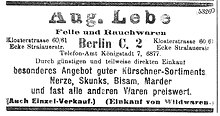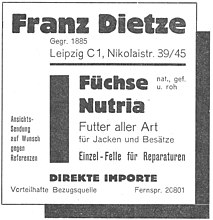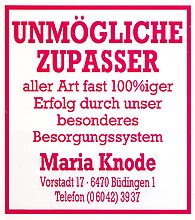Admirer
As Zupasser in are fur industry which for fur transformations required, fur changes and fur repairs furs referred. Their procurement and trading in them represents an essential branch of the tobacco trade , the distribution of fur skins.
The first use of the term in German-speaking trade after the Second World War seems unclear.
At the furrier
Additional fur material is often required for the new design, the reworking of a piece of fur clothing for a customer by the furrier . Causes can be a larger model or a change to a larger clothing size. Additional fur may also be needed to repair areas that have worn away in the hair.

An Austrian specialist publication published after the Second World War stated:
“If enough material is available, this reshaping can be carried out without adding fur. Mostly, however, the piece that has already been worn is in need of repair because it is faulty. Then in many cases new material will have to be added as a supplement. At some times, when the public's purchasing power is greatly reduced due to the economic depression, the new form is the main occupation of the furrier.
Even in times of war, when no new skin material was available, one was increasingly dependent on reworking. It was then particularly important to make the best and most beautiful imaginable from the available material, to restore it to its "shine". Prudence, inventiveness, and skill were the main requirements.
There are also companies, such as individual workshops, that deal exclusively with reworking and find a good living with it. "
It soon turned out that for many small and medium-sized furrier shops, fur remodeling remained the main activity, especially due to the increase in fur clothing. The furs sold in large numbers by clothing stores and other textile suppliers came to the furrier for the so-called service work, since the textile trade companies usually did not offer this work.
Zupasser skins are often too fresh in color compared to the fur worn. In the case of the naturally gray Persian in particular , this can be compensated for by refreshing the color of the old, yellowed fur material. Otherwise, many furriers have traditional recipes with which they adapt the new skins to the old to a limited extent. Dyed furs pose a particular problem, apart from black. The trade will only rarely have suitable skins in stock. Adaptive bleaching or coloring may be possible, but due to the fact that the color is usually only approximately the same, this involves a significant risk. However, as early as the 1930s the Leipzig company Walter Starke offered to dye repair skins according to the part to be repaired. If a fur is recolored for a redesign, the fur refiner colors the added fur in the best possible way. Since the dyeing always has to be of a much darker color, the result is usually relatively good, despite the fact that old and new goods react differently to the dye bath and are therefore treated differently by the dyer.
When redesigning the model, less well-fitting skins are incorporated into hidden areas, such as the under sleeves or under the arms, if possible. Even in the case of a repair, it may be necessary to use the new material on these less visible parts for an optimal or even acceptable result, for example when touching up worn leading edges. The actual repair can then be carried out with the fur that has fallen out - provided the color and structure of the hair match.
An important issue when procuring supplies by parcel service, formerly post or rail express, is the liability in the event of the loss of the sometimes extremely valuable furs. The furriers are regularly insured by what is known as "transport insurance" for customer goods, which, contrary to their name, covers the entire risk of storage at the retailer, including the transport risk for shipping there and back. Their sums are reported to the insurer, usually on a monthly basis.
In the tobacco shop
The color of a fur is an essential quality and value feature in trade. Dark fur, which has hardly been bleached by the sun and has silky hair, is the best. Feline and others). At the other end of the color scale are the faded, more brittle pelts called “red”. These actually undesirable color variants are usually particularly well suited as trimmers for customer furs that have also faded to a greater or lesser extent during use and due to aging.
During the boom in fur demand after the Second World War, the procurement of accessories in the tobacco shop was seen as a nuisance, but unfortunately a necessary evil for customer care. Corresponding offers in advertisements, for example, are almost impossible to find in the specialist magazines of the 1970s. This changed with the slowdown in the industry; As the proportion of the Zupasser business increased as a result, individual tobacco retailers began to advertise, for example, red or old-colored skins for Zupasser purposes. In 1955 there was only one dealer in the fur trade in Germany expressly offering Zupasserfelle; in 1985 there were already 10 companies advertising this branch of business. There was even an increasing number of advertisements specifically for old “ refined ” skins. In 1988, Hilchenbacher Pelzveredlung made “Irish mink look very old” with its “oldie process” . In 1996, the company HJ Fritzsche offered raccoon pelts that were blinded in old colors . There are also always trading companies that sell worn furs or parts thereof for purposes of dressing. In the USA, where the trade in second-hand accessory material is more common than in Germany, a reduction of 25 to 50 percent in material costs was expected in 1950 when using worn versus new fur.
For processing by the furrier company, wholesalers usually pre-sort the skins into so-called furrier bundles or assortments, which contain material for a coat or a jacket each. The attempt is made to leave as few “residues” as possible. Unfortunately, these skins that do not fit into the assortment are often not suitable for matching purposes. When the retailer inquires about a fitting, time and again they have to decide whether they should "tear apart" a matching assortment in order to keep the remaining skins in stock for an indefinite period of time, which are no longer sufficient for a ready-made item.
- Zupasser advertising in specialist publications through the ages
Fur trading center Niddastraße
After the Second World War, the procurement of the Zupasser in the Federal Republic of Germany was mainly handled by the tobacco merchants located in and around Frankfurt's Niddastrasse. Until the beginning of the 21st century, the fur trade concentrated here, in the way that Leipzig Brühl had until 1945 . Among several branch bowling clubs there was even one that called itself ambiguously "Die Zupasser".
This massing of the specialty trade increased the probability of receiving the best possible skins and not a regretful rejection. Either the furriers came here directly to find out about new products and to keep an eye out for cheap offers, which is still happening today when the number of suppliers and customers is significantly reduced. Or they hire a commission agent on site. Due to his overview of the skin storage, the commission agent is able to procure difficult accessories for his furrier customers. In the 1970s, he received a brokerage fee of 2 to 5 percent for his work, and more for the laborious additions, which were usually handled on his own account. The commission agents often keep their own stocks in stock, especially for the registration orders.
The commission agent Bernd Klebach reported that as an apprentice he spent a large part of his working time looking for passports and issuing delivery notes. In the “ Europahaus ”, Niddastraße 62, there was a small canteen, where members of the industry fed and exchanged new products: “Admissions were handed in, people asked about goods and of course the gossip flourished”. Klebach noted with approval that the company Thorer & Co. had developed its own scheme for the qualification of Persian varieties, “which makes the search for matchers much easier and deals with broad tails, mink, ocelot and various trimmings for ladies' wear ) ".
Another Frankfurt commission agent, Rudolf Sonntag, wrote in a gloss that was published in the “Pelzmarkt” and in 1970 as a bound volume that he was frustrated with the supply of supplies:
- “The commission agent was already very nervous and exhausted when he and his advisor rushed to the forty-ninth company. He didn't even know what kind of animals he was looking for so eagerly. [...]
- “Cockchafer throats, slate-colored, what a surprise. Haven't seen the article in decades. You can't believe what the ravages of time have made of it. That was once my specialty in the years around nineteen hundred and terrible. No, thank God I don't have a single fur left. "[...]
- At least now he knew what kind of material it was. With fresh courage he went on his way, and after only two more days he had actually found eleven slate-colored cockchafer throats from the corner of a tobacco shop. They didn't quite match the color, but he was proud and happy to have found something similar, especially since his customer had called several times and warned to hurry. [...]
- After a fortnight the eleven cockchafer throats came back. Without any comment. [...] "
In 1970 , the Central Association of the Furrier Trade set up a collection point at Werner Loh, Niddastraße 56, to bring the remaining skins stored by the furriers to the market . Here, the furriers were able to give their leftover skins on commission for a fee. Forgotten "Zupasser skins, umbrellas, lighters, hats, etc." have been collected from Fell-Union since January 1973, which had given a corner in their large shop windows as a "Brühl's showcase".
The company Herbert Blume Nachf. KG., Niddastraße 56, advertised in 1985 in the specialist directory of the fur industry, in addition to many types of fur, for the first time and particularly highlighted for their range of Zupassern. In 1989 they went one step further and advertised, now as the main offer, "old-colored mink", then in 1991 with the addition "in many colors and mutations".
See also
Web links
Individual evidence
- ↑ A.lexander Tuma: Pelz-Lexikon. Fur and Rauhwarenkunde, Volume XX . Alexander Tuma, Vienna 1950, p. 39 , keyword “new composition” .
- ↑ Arthur Hermsdorf, Gerd Kursawe, Peter Tonert: The fur wholesale after 1945 . In: Die Pelzwirtschaft, issue 11-12, 1985, pp. 7-8.
- ↑ Homepage of the Hermann Kanus company , offering to bleach and dye Zupasser appropriately. Last accessed July 3, 2019.
- ↑ Walter Starke: Guide for the furrier with a price list . Leipzig, undated, probably 1938, p. 17 (→ table of contents) .
- ^ A b David G. Kaplan: The Fur Book . Copyright The Reuben H. Donnelley Corporation, New York 1950, pp. 180, 190-191 (English).
- ↑ Who is liable for Zupasser samples? . In: Winckelmann Pelzmarkt No. 359, p. 14. Primary source: Schunck's Information , June 1976.
- ↑ Rudolf Sonntag: Die Plage (gloss). In: Winckelmann Pelzmarkt No. 322, February 6, 1976, pp. 16-17.
- ↑ Peter A. Thust, Frankfurt am Main, advertisement: […] Ocelots also red fur for Zupasser purposes . 4th August 1978.
- ^ Advertisement Hilchenbacher Lederwerke und Pelzveredlung AG; Bernd Klebach, Frankfurt am Main, March 1988.
- ^ Advertisement by HJ Fritzsche GmbH, Rauchwarenhandlung, November 1996 .
- ↑ Arthur Samet: Pictorial Encyclopedia of Furs . Arthur Samet (Book Division), New York 1950, p. 385. (English)
- ↑ Paul Schöps among others: The range of tobacco products. Technological fur dictionary No. 5. Hermelin-Verlag Dr. Paul Schöps, Leipzig, Berlin, 1949.
- ↑ Without indication of the author: New cone cup . In: Winckelmann Pelzmarkt No. 105, November 5, 1971, Winckelmann Verlag, Frankfurt am Main, p. 10.
- ↑ 3% brokerage rate accepted . Quote: At the association meeting on February 8, 71, the manipulators subsequently approved the increase in the commission agent's brokerage rate to 3% with a majority. Exceptions are provided for larger contracts as well as for raw goods . In: Winckelmann Pelzmarkt No. 66, February 5, 1971, Winckelmann Verlag Frankfurt am Main, p. 9.
- ↑ Bernd Klebach: The Brühl, the Niddastraße, the fur center. Memories of 35 years of tobacco industry . Self-published, June 2006, pp. 10, 14, III / 44.
- ↑ Rudolf Sonntag: "I have to consider ...!" . Winckelmann-Verlag, Frankfurt am Main, 1970, pp. 41-42.
- ↑ Signed "F.": Recently Zupasser headquarters in Frankfurt . In: Die Pelzwirtschaft issue 12, December 1970, p. 61.
- ↑ Brühl's treasure chest . In: Winckelmann Pelzmarkt No. 165, January 12, 1973.
- ↑ Winckelmann specialist address books.







